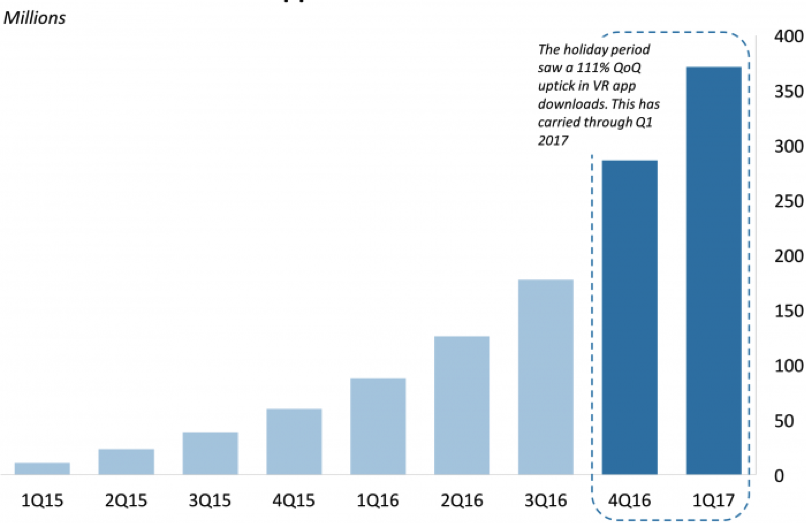|
VR Downloads Grow Exponentially
April 24, 2017 Last year, global downloads of VR games and apps from the App Store and Google Play grew 276% Y/Y, totaling 226 million downloads, according to new data from Sensor Tower. The data suggests there's healthy demand for VR content, despite sluggish adoption of dedicated VR headsets. As with traditional mobile apps, games represented the largest category of VR apps, at 56% of total downloads. That was followed by entertainment apps with 17%, and photo and video apps with 10%. Of note is the large volume of VR apps from the App Store, notwithstanding Apple’s lack of a headset. App Store downloads increased 727% in 2016, while Google Play downloads grew 424% Y/Y. Download growth will likely continue through 2017, Sensor Tower notes. This growth will be driven by three primary factors:
In 2016, new VR headsets like the Oculus Rift and the HTC Vive debuted amid great consumer anticipation, while VR content launches kept pace, with Batman: Arkham VR and Chair In A Room garnering encouraging download totals. At the same time, industry groups and conferences brought developers, investors, and content producers together, helping to further ramp up buzz in this nascent space. BI Intelligence, Business Insider’s premium research service, forecasts shipments of VR headsets to spike by 1047% year-over-year (Y/Y) to 8.2 million in 2016. This growth will help propel the virtual reality space to exceed $1 billion in revenue for the first time, according to research by Deloitte. Powering that growth is an estimated 271% increase in investment in AR (augmented reality) and VR companies from 2015, according to estimates from CB Insights. VR headset shipments are expected to grow in the years ahead, driven by the introduction of new content that will appeal to a broad swath of users. Jessica Smith, research analyst for BI Intelligence, has compiled a detailed report on virtual reality that explores the highly fragmented and volatile VR market that emerged in 2016, lays out the future growth potential in numerous key VR hardware categories as driven by major VR platforms, and examines consumer sentiment and developer excitement for VR, presenting which headset categories and platforms are most poised for success in the near- to mid-term. Here are some key takeaways from the report:
Figure 1: Cumulative VR App Downloads (m) Source: Sensor Tower 2017
virtual reality revenues will reach $7.17 billion by the end of this year, according to a new report by Greenlight Insights, which is also predicting that global VR revenues will total close to $75 billion by 2021. Figure 2: Global VR Industry Revenue Forecast 2017-2021 Source: Sensor Tower 2017
More than 65 percent of all VR revenues will come from headset sales this year, according to Greenlight. Consumer content will make up for around 12 percent, and VR cameras will make up another 11.6 percent. Over the next five years, the revenue split will slowly shift, with enterprise — think VR for construction companies, education etc. — making up for 24.2 percent of all revenue in 2021. Figure 3: VR—Source of Revenue Comparison 2017 & 2021 Source: Greenlight
Greenlight also forecast that location-based virtual reality in malls and movie theaters is going to grow into a significant part of the industry. In 2017, location-based VR will bring in $222 million worldwide; by 2021, that amount will have grown to almost $1.2 billion. These estimates have to be taken with a grain of salt — it’s a nascent industry, after all. Adding to the uncertainty is the fact that many of the major headset manufacturers, including Oculus, HTC and Google, have yet to release any actual sales numbers for their devices.
|
Vertical Divider
|
|
Contact Us
|
Barry Young
|



